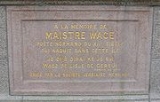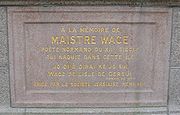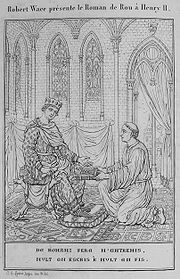
Wace
Encyclopedia


Normans
The Normans were the people who gave their name to Normandy, a region in northern France. They were descended from Norse Viking conquerors of the territory and the native population of Frankish and Gallo-Roman stock...
poet
Poet
A poet is a person who writes poetry. A poet's work can be literal, meaning that his work is derived from a specific event, or metaphorical, meaning that his work can take on many meanings and forms. Poets have existed since antiquity, in nearly all languages, and have produced works that vary...
, who was born in Jersey
Jersey
Jersey, officially the Bailiwick of Jersey is a British Crown Dependency off the coast of Normandy, France. As well as the island of Jersey itself, the bailiwick includes two groups of small islands that are no longer permanently inhabited, the Minquiers and Écréhous, and the Pierres de Lecq and...
and brought up in mainland Normandy
Normandy
Normandy is a geographical region corresponding to the former Duchy of Normandy. It is in France.The continental territory covers 30,627 km² and forms the preponderant part of Normandy and roughly 5% of the territory of France. It is divided for administrative purposes into two régions:...
(he tells us in the Roman de Rou that he was taken as a child to Caen
Caen
Caen is a commune in northwestern France. It is the prefecture of the Calvados department and the capital of the Basse-Normandie region. It is located inland from the English Channel....
), ending his career as Canon
Canon (priest)
A canon is a priest or minister who is a member of certain bodies of the Christian clergy subject to an ecclesiastical rule ....
of Bayeux
Bayeux
Bayeux is a commune in the Calvados department in Normandy in northwestern France.Bayeux is the home of the Bayeux Tapestry, which depicts the events leading up to the Norman conquest of England.-Administration:Bayeux is a sub-prefecture of Calvados...
.
Life
All that is known of Wace's life comes from autobiographical references in his poems. He neglected to mention his birthdate; sometime between 1090 and 1110 is the most commonly accepted year of his birth.The name Wace, used in Jersey until the 16th century, appears to have been his only name; surname
Surname
A surname is a name added to a given name and is part of a personal name. In many cases, a surname is a family name. Many dictionaries define "surname" as a synonym of "family name"...
s were not universally used at that time.
It is speculated that he may have been of aristocratic origin, as he was sent to Caen
Caen
Caen is a commune in northwestern France. It is the prefecture of the Calvados department and the capital of the Basse-Normandie region. It is located inland from the English Channel....
to be educated, which would have been virtually impossible for most. His detailed writing on maritime matters may have stemmed from his island upbringing.
Around 1130 Wace returned to Caen and took ecclesiatical work, possibly as a teacher.
Works
His extant works include the Roman de BrutRoman de Brut
Roman de Brut or Brut is a verse literary history of Britain by the poet Wace. Written in the Norman language, it consists of 14,866 lines....
, a verse history of Britain, the Roman de Rou
Roman de Rou
Roman de Rou is a verse chronicle by Wace in Norman covering the history of the Dukes of Normandy from the time of Rollo of Normandy to the battle of Tinchebray in 1106...
, a verse history of the Dukes of Normandy
Duchy of Normandy
The Duchy of Normandy stems from various Danish, Norwegian, Hiberno-Norse, Orkney Viking and Anglo-Danish invasions of France in the 9th century...
, and other works in verse, including the Lives of Saint Margaret and Saint Nicholas
Saint Nicholas
Saint Nicholas , also called Nikolaos of Myra, was a historic 4th-century saint and Greek Bishop of Myra . Because of the many miracles attributed to his intercession, he is also known as Nikolaos the Wonderworker...
.
Roman de Brut
Roman de Brut (c. 1155) was based on the Historia Regnum Britanniae of Geoffrey of MonmouthGeoffrey of Monmouth
Geoffrey of Monmouth was a cleric and one of the major figures in the development of British historiography and the popularity of tales of King Arthur...
. It cannot be regarded as a history in any modern sense, although Wace often distinguishes between what he knows and what he does not know, or has been unable to find out. Wace narrates the founding of Britain by Brutus of Troy
Brutus of Troy
Brutus or Brute of Troy is a legendary descendant of the Trojan hero Æneas, known in mediæval British legend as the eponymous founder and first king of Britain...
to the end of the legendary British history created by Geoffrey of Monmouth. The popularity of this work is explained by the new accessibility to a wider public of the Arthur legend in a vernacular language. In the midst of the Arthurian section of the text, Wace was the first to mention the legend of King Arthur
King Arthur
King Arthur is a legendary British leader of the late 5th and early 6th centuries, who, according to Medieval histories and romances, led the defence of Britain against Saxon invaders in the early 6th century. The details of Arthur's story are mainly composed of folklore and literary invention, and...
's Round Table
Round Table (Camelot)
The Round Table is King Arthur's famed table in the Arthurian legend, around which he and his Knights congregate. As its name suggests, it has no head, implying that everyone who sits there has equal status. The table was first described in 1155 by Wace, who relied on previous depictions of...
and the first to ascribe the name Excalibur
Excalibur
Excalibur is the legendary sword of King Arthur, sometimes attributed with magical powers or associated with the rightful sovereignty of Great Britain. Sometimes Excalibur and the Sword in the Stone are said to be the same weapon, but in most versions they are considered separate. The sword was...
to Arthur's sword, although on the whole he adds only minor details to Geoffrey's text.
The Roman de Brut became the basis, in turn, for Layamon
Layamon
Layamon or Laghamon (ˈlaɣamon; in American English often modernised as ; ), occasionally written Lawman, was a poet of the early 13th century and author of the Brut, a notable English poem of the 12th century that was the first English language work to discuss the legends of Arthur and the...
's Brut
Brut (Layamon)
Layamon's Brut , also known as The Chronicle of Britain, is a Middle English poem compiled and recast by the English priest Layamon. The Brut is 16,095 lines long and narrates the history of Britain: it is the first historiography written in English since the Anglo-Saxon Chronicle...
, an alliterative Middle English poem, and Piers Langtoft
Piers Langtoft
Peter Langtoft, also known as Peter of Langtoft was an English historian and chronicler who took his name from the small village of Langtoft in the East Riding of Yorkshire....
's Chronicle. Historian Matthew Bennett, in an article entitled "Wace and warfare," has pointed out that Wace clearly had a good understanding of contemporary warfare, and that the details of military operations he invents to flesh out his accounts of pseudo-historical conflicts can therefore be of value in understanding the generalities of warfare in Wace's own time.
Roman de Rou
His later work, the Roman de Rou, was, according to LayamonLayamon
Layamon or Laghamon (ˈlaɣamon; in American English often modernised as ; ), occasionally written Lawman, was a poet of the early 13th century and author of the Brut, a notable English poem of the 12th century that was the first English language work to discuss the legends of Arthur and the...
, commissioned by King Henry II of England
Henry II of England
Henry II ruled as King of England , Count of Anjou, Count of Maine, Duke of Normandy, Duke of Aquitaine, Duke of Gascony, Count of Nantes, Lord of Ireland and, at various times, controlled parts of Wales, Scotland and western France. Henry, the great-grandson of William the Conqueror, was the...
. A large part of the Roman de Rou is devoted to William the Conqueror
William I of England
William I , also known as William the Conqueror , was the first Norman King of England from Christmas 1066 until his death. He was also Duke of Normandy from 3 July 1035 until his death, under the name William II...
and the Norman Conquest. Wace's reference to oral tradition within his own family suggests that his account of the preparations for the Conquest and of the Battle of Hastings
Battle of Hastings
The Battle of Hastings occurred on 14 October 1066 during the Norman conquest of England, between the Norman-French army of Duke William II of Normandy and the English army under King Harold II...
may have been reliant not only on documentary evidence but also on eyewitness testimony from close relations—though no eyewitnesses would have been still alive when he began work on the text. The Roman de Rou also includes a mention of the appearance of Halley's Comet
Comet Halley
Halley's Comet or Comet Halley is the best-known of the short-period comets, and is visible from Earth every 75 to 76 years. Halley is the only short-period comet that is clearly visible to the naked eye from Earth, and thus the only naked-eye comet that might appear twice in a human lifetime...
. The relative lack of popularity of the Roman de Rou may reflect the loss of interest in the history of the Duchy of Normandy following the incorporation of continental Normandy into the kingdom of France in 1204.
Language
The Anglo-Norman languageAnglo-Norman language
Anglo-Norman is the name traditionally given to the kind of Old Norman used in England and to some extent elsewhere in the British Isles during the Anglo-Norman period....
Wace wrote in is variously regarded as a dialect of the Norman language
Norman language
Norman is a Romance language and one of the Oïl languages. Norman can be classified as one of the northern Oïl languages along with Picard and Walloon...
, a dialect of Old French
Old French
Old French was the Romance dialect continuum spoken in territories that span roughly the northern half of modern France and parts of modern Belgium and Switzerland from the 9th century to the 14th century...
, or specifically the precursor of Jèrriais
Jèrriais
Jèrriais is the form of the Norman language spoken in Jersey, in the Channel Islands, off the coast of France. It has been in decline over the past century as English has increasingly become the language of education, commerce and administration...
. Writers in Jersey have looked on Wace as the founder of Jersey literature, and Jèrriais is sometimes referred to as the language of Wace although the poet himself predated the development of Jèrriais as a literary language. Wace is the earliest known Jersey writer.
Although the name Robert has been ascribed to Wace, this is a tradition resting on little evidence. It is generally believed nowadays that Wace only had one name. As a clerc lisant, he was proud of his title of Maistre (master) and is consequently sometimes referred to as Maistre Wace.
There is a granite memorial stone to Wace built into the side of the States Building in Jersey
Jersey
Jersey, officially the Bailiwick of Jersey is a British Crown Dependency off the coast of Normandy, France. As well as the island of Jersey itself, the bailiwick includes two groups of small islands that are no longer permanently inhabited, the Minquiers and Écréhous, and the Pierres de Lecq and...
's Royal Square. This includes a quote from the Roman de Rou that expresses the poet's pride in his place of birth:
- Jo di e dirai ke jo sui
- Wace de l’isle de Gersui
Modern Jèrriais:
- J'dis et dithai qu'jé sis
- Wace dé l'Île dé Jèrri
Modern French:
- Je dis et dirai que je suis
- Wace de l'île de Jersey
English:
- I say and will say that I am
- Wace from the Island of Jersey

